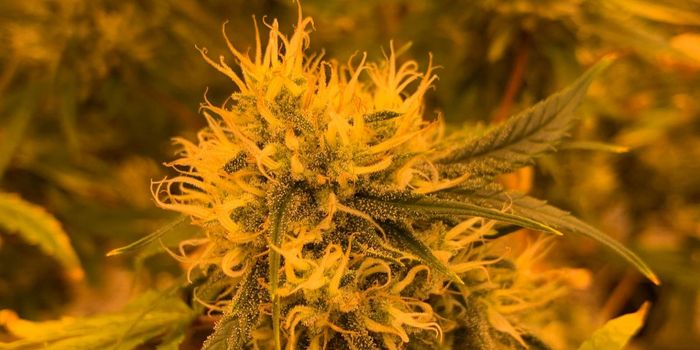Δ9-THCP: The Novel Phytocannabinoid with Higher Cannabimimetic Activity than THC
Two novel phytocannabinoids from Cannabis sativa L. have been identified – one with a higher in vivo cannabimimetic activity than Δ9-tetrahydrocannabinol (Δ9-THC), and another that is a homolog of cannabidiol (CBD).
The study – published in Nature’s Scientific Reports – initially aimed to characterize the phytocannabinoid profile of a medicinal cannabis variety from Italy, FM2. However, Ultrahigh-resolution liquid chromatography-heated electrospray ionization-Orbitrap (UHPLC-HESI-Orbitrap) metabolomic profiling of FM2 plant extracts revealed the presence of two novel phytocannabinoids with astoundingly similar chemical structures to two of the most extensively studied cannabinoids in the field (i.e., Δ9-THC and CBD).
More specifically, the study isolated and characterized two novel phytocannabinoids – ‘(-)-trans-Δ9-tetrahydrocannabiphorol (Δ9-THCP)’ and ‘cannabidiphorol (CDBP)’– typified by resorcinyl moieties with seven-carbon alkyl chains.
Phytocannabinoid Structure & Pharmacological Implications of Alkyl Side Chain Length on Δ9-THC’s Biological Activity
During phytocannabinoid biosynthesis, an enzymatic reaction between a resorcinol and an isoprenoid group gives rise to their general chemical structure. These two features can be modified to produce a variety of different phytocannabinoids, with over 150 annotated phytocannabinoids derived from these modifications.
The naturally-occurring phytocannabinoids predominantly found in C. sativa L. are biosynthesized from olivetolic acid and geranyl pyrophosphate. All phytocannabinoids are initially synthesized as carboxylated (i.e. acidic) compounds. Accordingly, these two precursor compounds participate in a condensation reaction to generate cannabigerolic acid (CBGA).
CBGA can then undergo chemical modification via catalysis by designated cyclase enzymes to generate either tetrahydrocannabinolic acid (THCA), cannabidolic acid (CBDA), or cannabichromenic acid (CBCA). Heating of the phytocannabinoids in their carboxylated form converts them into their decarboxylated (i.e., neutral) analogues.
Previous research has shown that the length of the alkyl side chain on the resorcinyl moiety is the principal attribute that influences Δ9-THC’s biological activity on the human cannabinoid receptor (CB1) – thus implicating a role for the alkyl side chain length as Δ9-THC’s pharmacophore.
Within the alkyl side chain, at least three carbons are necessary for CB1 receptor binding and a maximum of eight carbons (which exert the highest activity before decreasing with additional carbons), as evidenced by structure-activity relationship (SAR) experiments.
Major neutral cannabinoids (such as Δ9-THC and CBD), minor neutral cannabinoids (cannabigerol, CBG; cannabinol, CBN; and cannabichromene, CBC) and their respective acidic counterparts (CBGA, Δ9-THCA, CBDA, CBCA) are all characterized by a five-carbon alkyl chain on each of their resorcinyl moieties.
Phytocannabinoids characterized by other various alkyl side chain lengths have also been identified. For example, varinoids (i.e., cannabidivarin, CBDV; Δ9-tetrahydrocannabivarin, Δ9-THCV) feature three carbon atoms in their respective alkyl side chains. Orcinoids (i.e., cannabidiorcol, CBD-C1; tetrahydrocannabiorcol, THC-C1), on the other hand, contain just one carbon atom in their alkyl side chain.
Significance of the Study – Why Does This Matter?
The research team that led the aforementioned THCP/CDBP study is the first to describe any naturally-occurring phytocannabinoid characterized by a linear alkyl side chain with more than five carbon atoms.
The two novel compounds were each isolated (in both their carboxylated and decarboxylated forms) from FM2 phytocannabinoid extracts, and their absolute configuration was validated using stereoselective synthesis. Further analysis confirmed that Δ9-THCP and CBDP are structural analogs of Δ9-THC and CBD, respectively, which differ from their canonical counterparts in the length of their corresponding alkyl chains.
The research team named the novel compounds based on the presence of their distinct “sphaerophorol” resorcinyl moiety (5-heptyl-benzen-1,3-diol), which is distinguished by its seven-carbon alkyl side chain. These names were proposed by the authors in accordance with the International Nonproprietary Names (INN) Programme and Classification of Medical Products, established by the World Health Organization.
Increasingly over the past few decades, more research has provided promising evidence in support of the therapeutic effects of cannabinoids. In particular, the pharmacological potential of Δ9-THC has received notable attention from the medical science community. This popularity is vastly derived from Δ9-THC’s psychotropic capacity, which is also responsible for the majority of the intoxicant effects of cannabis.
Assessing Cannabimimetic Activity: Determining Δ9-THCP’s Binding Affinity for Human Cannabinoid Receptors, CB1/CB2
Based on the results of the SAR experiments described above, and in addition to emerging evidence supporting the pharmacological potential of Δ9-THC, the team chose to further interrogate the psychotropic potential of Δ9-THCP.
Specifically in the case of Δ9-THCP, this transmutes experimentally to assessing the cannabimimetic activity of Δ9-THCP as indicated by the phytocannabinoid’s binding affinity for human cannabinoid receptors CB1/CB2.
Due to Δ9-THCP’s structural similarity to Δ9-THC (with the exception of an increased alkyl side chain length in the former), researchers expected that the increased number of carbons in Δ9-THCP’s alkyl side chain would translate to Δ9-THCP having enhanced cannabimimetic activity relative to Δ9-THC.
Using a radiolabeled ligand binding assay, Δ9-THCP’s binding affinity for the CB1/CB2 receptors was measured relative to Δ9-THC, with radiolabeled CP55940 (potent, full CB1 receptor agonist with potent pharmacological effects) and WIN 55212-2 (potent, selective CB2 receptor agonist) employed, respectively, as reference compounds for CB1 and CB2 receptor binding.
Briefly, the in vitro binding affinity of each compound was determined from measuring the degree of binding of the radiolabeled compounds to the receptor at a set of varying concentrations while in the presence of an unlabeled potent agonist (i.e., competition inhibition). These measurements were used to generate each compound’s respective dose-response curve for each cannabinoid receptor and to calculate each compound’s respective inhibition constant (Ki).
The Ki was used to quantitatively express each phytocannabinoid’s degree of binding affinity for each receptor tested. Ki measures binding affinity independent of radioligand concentration, thus serving as an unbiased and intrinsic quantification parameter. Generally, a lower Ki indicates increased binding affinity of the compound being assessed in radioligand binding assays.
Results – What They Found
Δ9-THCP’s binding to the human CB1 receptor in vitro (inhibition constant, Ki = 1.2 nM) was found to be 33-times more active than Δ9-THC (Ki = 40 nM), 63-times more active than Δ9-THCV (Ki = 75.4 nM), 13-times more active than Δ9-tetrahydrocannabutol (Δ9-THCB; Ki = 15 nM), and almost as potent as CP55940 (Ki = 0.9 nM).
Δ9-THCP also bound with high affinity to the CB2 receptor in vitro (Ki= 6.2 nM) – approximately five to ten times more actively than Δ9-THC, Δ9-THCB, and Δ9-THCV (with Kivalues spanning from 36 to 63 nM).
Furthermore, Δ9-THCP exhibited THC-like cannabimimetic activity in vivo during tetrad behavioral tests in mice, as evidenced by induction of hypomotility, analgesia, catalepsy, and decreased rectal temperature following intraperitoneal injection with Δ9-THCP.
What This Means, Future Directions, & Real-World Relevance
The results of this study suggest that the pharmacological effects of certain cannabis cultivars that are unable to be exclusively attributed to Δ9-THC could be due to the cannabimimetic activity of Δ9-THCP. Moreover – and in-line with their original hypothesis – the researchers concluded that Δ9-THCP does indeed exhibit increased cannabimimetic activity relative to Δ9-THC. Experiments further interrogating the pharmacological activity of Δ9-THCP, as well as delving into that of CBDP, are currently underway. The identification of these two novel phytocannabinoids harbors encouraging pharmacological and therapeutic potential for the treatment of an array of clinical conditions.
Sources: Nature’s Scientific Reports (1); Glosbe Dictionary; Antioxidants (Basel, Switzerland); Perspectives in Medicinal Chemistry; Springer Link’s Encyclopedia of Cancer; Nature’s Scientific Reports (2); Natural Product Reports; World Health Organization (WHO)’s Health Product and Policy Standards; Methods in Molecular Biology; Tocris Biotech; AAT Bioquest; Merriam-Webster Dictionary









